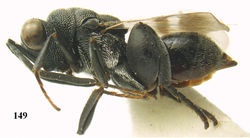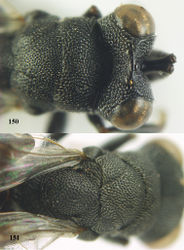Hockeria guptai
| Notice: | This page is derived from the original publication listed below, whose author(s) should always be credited. Further contributors may edit and improve the content of this page and, consequently, need to be credited as well (see page history). Any assessment of factual correctness requires a careful review of the original article as well as of subsequent contributions.
If you are uncertain whether your planned contribution is correct or not, we suggest that you use the associated discussion page instead of editing the page directly. This page should be cited as follows (rationale):
Citation formats to copy and paste
BibTeX: @article{Narendran2016ZooKeys, RIS/ Endnote: TY - JOUR Wikipedia/ Citizendium: <ref name="Narendran2016ZooKeys">{{Citation See also the citation download page at the journal. |
Ordo: Hymenoptera
Familia: Chalcididae
Genus: Hockeria
Name
Hockeria guptai Narendran, 1989 – Wikispecies link – Pensoft Profile
- Hockeria guptai Narendran, 1989: 109 (♀, holotype, India (CNC)).
Material
1 ♀ (RMNH), “C. Vietnam: Ha Tinh, Vu Quang N. P., by hand[net], 1.x.2009, R. de Vries, RMNH’09”.
Diagnosis
This species comes very near Hockeria tristis (Strand) because of the colour of the body and wings and in having micro-sculpture on the propodeum, but differs from Hockeria tristis in having: 1) T1 smooth and shiny (in Hockeria tristis T1 densely micro-sculptured); 2) mesopleuron not densely micro-sculptured as in Hockeria tristis and 3) apex of scutellum not as deeply emarginated as in Hockeria tristis.
Description
(based on specimen from Vietnam). ♀, length of body 4.8 mm.
Colour. Black with following parts as follows: eyes dull yellowish brown with dull brownish patches; ocelli pale reflecting yellow; fore and mid tarsi blackish brown; fore wing hyaline with 2 brown infuscations and a white patch adjacent to STV.
Head. Width of head in anterior view 1.2 × its height, distinctly wider than mesosoma (27:23); vertex and temples not narrow; POL 2.7 × OOL; AOL subequal to OOL; width between eyes 2.5 × POL; pre-orbital carina distinct, not distinctly joining malar sulcus, vertex with a carina -like ridge behind anterior ocellus (this ridge not clearly joining pre-orbital carinae to form a distinct horse-shoe like pre-orbital carina); height of malar sulcus 0.7 × height of eye in profile; eye height 1.3 × eye length in profile; post-orbital carina absent; geno-temporal furrow shallow; scrobe reaching anterior ocellus, cross reticulate-striate. Antennal scape reaching anterior ocellus. Relative lengths of antennal segments:scape = 57, pedicel = 15; ring segment = 7; F1 = 14; F2 = 15; F3 = 14; F4 = 13; F5 = 12.5; F6 = 11.5; F7 = 9; clava = 23.4.
Mesosoma. Mesosoma with close, umbilicate, setigerous pits, interstices carinate and rugose; posterior margin of pronotum arched posteriorly; length of middle lobe of mesoscutum a little shorter than scutellum (8:10); scutellum as long as wide, high in profile, apex bi-lobed. Propodeum with dense characteristic micro-sculpture on spaces between longitudinal carinae on sides; interstices densely micro-sculptured; postspiracular teeth well developed; callus with dense setae.
Wings. Fore wing 2.9 × longer than wide; relative length of SMV = 37; MV = 10; PMV = 4; STV = 2.
Legs. Hind coxa striate dorsally, densely pubescent ventrally; hind femur bi-lobed, 1.8 × as long as broad.
Metasoma. Metasoma subequal in length to mesosoma, 1.8 × as long as its width in dorsal view; T1 smooth and shiny; T2 smooth and shiny on dorso-median area, pubescent on dorso-lateral side; T6 densely rugose and weakly punctate; epipygium a little longer than ovipositor sheath in dorsal view.
Male. Unknown.
Host
Unknown.
Distribution
Vietnam (new record), India, Malaysia (Narendran 1989[1]).
Variation
Length of ♀ varies from 4.0–4.8 mm; height of malar sulcus distinctly longer than height of eye in Vietnamese specimen (according to the original description MS is shorter than height of eye in profile); POL 2.7–2.8 × OOL; median carina of propodeum not indicated in Vietnamese specimen; basal pit of T1 indistinct in Vietnamese specimen.
Taxon Treatment
- Narendran, T; van Achterberg, C; 2016: Revision of the family Chalcididae (Hymenoptera, Chalcidoidea) from Vietnam, with the description of 13 new species ZooKeys, (576): 1-202. doi
Images
|
Other References
- ↑ Narendran T (1989) Oriental Chalcididae (Hymenoptera: Chalcidoidea). Zoological Monograph. Department of Zoology, University of Calicut, Kerala, 1–441.

